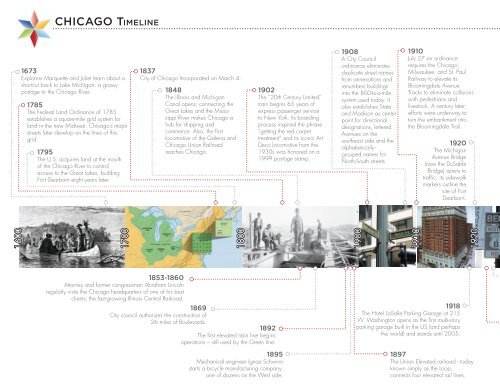Forward - City of Chicago
Forward - City of Chicago
Forward - City of Chicago
Create successful ePaper yourself
Turn your PDF publications into a flip-book with our unique Google optimized e-Paper software.
CHICaGo TImelIne<br />
1673<br />
Explorers Marquette and Joliet learn about a<br />
shortcut back to Lake Michigan: a grassy<br />
portage to the <strong>Chicago</strong> River.<br />
1785<br />
The Federal Land Ordinance <strong>of</strong> 1785<br />
establishes a square-mile grid system for<br />
land in the new Midwest. <strong>Chicago</strong>’s major<br />
streets later develop on the lines <strong>of</strong> this<br />
grid.<br />
1795<br />
The U.S. acquires land at the mouth<br />
<strong>of</strong> the <strong>Chicago</strong> River to control<br />
access to the Great Lakes, building<br />
Fort Dearborn eight years later.<br />
1837<br />
<strong>City</strong> <strong>of</strong> <strong>Chicago</strong> Incorporated on March 4.<br />
1848<br />
The Illinois and Michigan<br />
Canal opens; connecting the<br />
Great Lakes and the Mississippi<br />
River makes <strong>Chicago</strong> a<br />
hub for shipping and<br />
commerce. Also, the first<br />
locomotive <strong>of</strong> the Galena and<br />
<strong>Chicago</strong> Union Railroad<br />
reaches <strong>Chicago</strong>.<br />
1902<br />
The “20th Century Limited”<br />
train begins 65 years <strong>of</strong><br />
express passenger service<br />
to New York. Its boarding<br />
process inspired the phrase<br />
“getting the red carpet<br />
treatment” and its iconic Art<br />
Deco locomotive from the<br />
1930s was honored on a<br />
1999 postage stamp.<br />
1908<br />
A <strong>City</strong> Council<br />
ordinance eliminates<br />
duplicate street names<br />
from annexations and<br />
renumbers buildings<br />
into the 800-to-a-mile<br />
system used today. It<br />
also establishes State<br />
and Madison as center<br />
point for directional<br />
designations, lettered<br />
Avenues on the<br />
southeast side and the<br />
alphabeticallygrouped<br />
names for<br />
North-South streets<br />
1910<br />
July 27 an ordinance<br />
requires the <strong>Chicago</strong>,<br />
Milwaukee, and St. Paul<br />
Railway to elevate its<br />
Bloomingdale Avenue<br />
Tracks to eliminate collisions<br />
with pedestrians and<br />
livestock. A century later,<br />
efforts were underway to<br />
turn the embankment into<br />
the Bloomingdale Trail.<br />
1920<br />
The Michigan<br />
Avenue Bridge<br />
(now the DuSable<br />
Bridge) opens to<br />
traffic; its sidewalk<br />
markers outline the<br />
site <strong>of</strong> Fort<br />
Dearborn.<br />
1600<br />
1700<br />
1800<br />
1900<br />
1910<br />
1920<br />
1853-1860<br />
Attorney and former congressman Abraham Lincoln<br />
regularly visits the <strong>Chicago</strong> headquarters <strong>of</strong> one <strong>of</strong> his best<br />
clients, the fast-growing Illinois Central Railroad.<br />
1869<br />
<strong>City</strong> council authorizes the construction <strong>of</strong><br />
26 miles <strong>of</strong> Boulevards.<br />
1892<br />
The first elevated train line begins<br />
operations – still used by the Green line.<br />
1895<br />
Mechanical engineer Ignaz Schwinn<br />
starts a bicycle manufacturing company,<br />
one <strong>of</strong> dozens on the West side.<br />
1918<br />
The Hotel LaSalle Parking Garage at 215<br />
W. Washington opens as the first multi-story<br />
parking garage built in the US (and perhaps<br />
the world) and stands until 2005.<br />
1897<br />
The Union Elevated railroad - today<br />
known simply as the Loop,<br />
connects four elevated rail lines.




